"Michael". The March offensive of the 1918 Kaiser army in France. Part of 5
Two hours of artillery fire was focused on British batteries, and then was moved to infantry positions. At 9 hours, the fire caught up in the firing shaft, which began a slow advance. Under his cover, thick chains of infantry of the German assault divisions rose from the trenches. By 10 hours, the British troops were completely suppressed by the fire of unprecedented forces. The offensive of three German armies began.
The 17 Army, advancing in a southwestern direction, acted against the most powerful enemy - and by the evening of March 21 it managed to reach only the second line of British positions, advancing to a depth of 2 - 3 km. 2-I army, advancing to the west, met strong resistance at the height of Epekhy. But the height was set aside from the north and south.
The combined strike of the 17 and 2 armies on the very first day of the operation went on an arc at Cambre. The 18 Army had the greatest success on the first day of the offensive - 21 advanced to the evening of March to the depth of 5 - 6 km.
March 22 also brought the Germans great success - they managed to seize the second line and overcome the British artillery positions.
The 17 Army moved southwards, and the 2 Army reached the Nürl-Golencourt line. The British in the area of Cambrai landed in a bag - and had to hurry to leave it. The most significant successes on this day were again on the front of the 18 Army - which reached the line of the Crozat Channel with its left flank, dropping the British 5 Army to the west bank of the latter. 5-I army suffered heavy losses.
Thus, on the second day of the operation, the tactical success of the Germans on the left flank, south of S. Kantin, was undoubtedly. The only question was whether their adversary would be in time to concentrate the necessary reserves in time.
This scenario was a complete surprise for the allies. D. Haig, as previously noted, was aware of the direction of the blow of the Germans - but the pace of development of the breakthrough was stunning. Yes, and a brief artillery preparation made one doubt whether the Germans were the main attack. The weakness of the right flank of the British and the tactics achieved by the Germans south of S. Kantin forced the French command of the 22 March to concentrate the 5 Army Corps (9 and 10 Infantry, 1 Cavalry Divisions) on the Crozat Canal. The French arrived, however, without artillery, but on the night of the 23, they occupied the battle area on the right flank of the British.
The achievement of the 18 th army line of the Crozat channel and the successful promotion of the latter to the Somme raised the question of developing success on the left flank before the German command. In 9 hours 15 minutes 23 in March E. von Ludendorff pointed to the need to pursue the British 2 and 18 armies over the river. Sommu In 10 hours 20 minutes followed by a directive, according to which the 17-I army was to attack Arras - S. Paul, and the left flank on Miromon. The 2 Army indicated the direction to Miromon - Lyon, and the 18 Army indicated on Scholne - Noyon.
1 schema. The direction of the onset of the German armies.
This moment was a turning point for the strategic development of the operation, radically changing the main directive to the offensive of “Michael” from March 10. According to the latter, the 18 Army was supposed to, after entering the line r. Somme, extend your right flank to Perron. Now, much of the 2 Army should have advanced south of the Somme. And with this the center of gravity of the operation moved to the southern flank, while in the northern one only a part of the 2 and 17 armies remained to strike.
Under the influence of tactical success on the left flank of the shock group, the German Main Apartment was more and more inclined to think about abandoning the original plan of defeating the British. Operational orders from 23 March transformed the original plan, breaking its core idea.
March 23 The 17 Army south of Skarpa launched an offensive on its right flank, while its main forces continued to advance in a southwesterly direction - on Bapom. The army was faced with the difficult task of reaching the left shoulder - in order to rearrange the front to the north-west.
2-th army 23 March reached the line p. Somme - at Perron and south of the latter. The successes on the front of the 18 Army, which forced the Somme and Crozat channel, were significant again. Thus, part of the 2 and 18 armies were already advancing in accordance with the new directive - in the western direction, on Amiens.
The new successes achieved by the Germans on March 23 and the launch of the Somme line made the position of the Allies very serious. On this day, the German long-range guns from the La Fer district began shelling Paris.
The British 3 Army still put up stubborn resistance north of the Somme and, especially, at Arras. But to the south, the position of the heavily damaged 5 Army became critical - and this seriously threatened the strength of the British-French interface.
The French 5 Corps 23 March was thrown back to Noyon - and along the course of the river. Oise formed a breakthrough between the British and French fronts. Although the Allies managed to “shut up” this breakthrough, the joint and the Paris direction were under threat. Now the French command hastily began to pull up its reserves. Parts of the 1 Army from the area west of Nancy were transferred by car to the Mondidier area. Here, together with the 3 Army, they formed a group of reserve armies under the command of General E. M. Fayol.
1. EM. Fayol.
24 March brought the Germans new major successes. Despite the persistent resistance of the British between Skarpa and Somme, the 17 Army managed to advance its left flank, take Bap and turn to the front to the west. The 2 Army broke through in the Komble area and entered the battlefields of the 1916 Somme of the year. In the Perron area, the left flank of the 2 Army forced the Somme. The 18 Army, meeting on the left flank already noticeable resistance of the French reserves in time, nevertheless advanced to the Nel-Noyon front.
On March 25, the Germans continued their offensive on the entire front - despite attempts by the French 3 Army to go on the offensive between the Somme and Oise. The 18 army responded with a blow in the direction of Mondidier. North, the Germans also continued to advance successfully - and the 17-I army, having overcome the British defenses south of the Skarpa, reached the sources of the r. Left flank. Ankr. Thus, the risky reversal of the left shoulder on almost 90 ° was O. von Belov successfully implemented.
26 March - the culmination of the operation "Michael". 17-I army developed an offensive to the north-west, 2-I army reached the river. Ankr and occupied Albert. The 18-I army captured Rua and Noyon, approaching Mondidier.
25 - March 26 Allied position has become critical. The British 3 Army, which received reserves and, after suffering relatively small losses, was driven back to the north-west. But the British 5-I army, retreating to Amiens, suffered huge losses, and by the evening of March 25 virtually ceased to exist. The front between the British and the French in the strip between Avra and Oise was broken through, and an 15-kilometer-long gap was formed between the allied armies. The inner flanks of the Allied fronts were exposed, and the fall of Amiens was to finally separate the Allied armies, leading to a catastrophe.
The Allied Command was in shock. D. Haig planned a retreat on the coast of the English Channel, and A. Petain prepared for the evacuation of Paris.
In one of the post-war articles, F. Foch described these days as follows: “Petain intended to retreat for Paris, and Haig to the sea. The gates were opened to the Germans, and this meant a complete defeat. "
All signs of demoralization appeared in the retreating British troops. On the roads leading to the west, there were parks, carts and refugees. Among the latter, there were also groups of exhausted British soldiers. An officer of the French 5 Cavalry Division recalled: "It was a sad picture of a lost battle, which we last observed in 1914 year."
If at this moment the Germans had thrown into the breakthrough cavalry formed between the British and the French (which continued to be in the East), a catastrophe was inevitable. That is what D. Haig thought. And on this difficult day, the Allied Military Council convened in Dullans - Lord A. Milner (member of the military office of D. Lloyd-George), General G. Wilson (Chief of the British General Staff), R. Poincare, J. Clemenceau, arrived to him. Petain, D. Haig and F. Foch. English Major Lytton, who attended the meeting, described the depressed mood of its participants, saying that the meeting was reminiscent of "a council of famous doctors by the bed of a dying patient."
Only F. Foch was more optimistic - and at Milner’s suggestion, in his person, finally, the commander-in-chief of all the allied armies was chosen, who was to "coordinate the operational actions of the allied armies in the French theater of military operations." True, the unified command of the de facto began to be realized only from April 3, when the “strategic leadership of military operations” was officially transferred to F. Foch at the conference in Beauvais. The title of commander in chief of all the allied armies F. Foch received only at the end of April. But the decision of the Dullan meeting was a turning point in the creation of the All-Union Command - which affected the state of affairs at the front.
Already on the night of March 27, the energetic and temperamental F. Foch outlined his operational considerations to D. Heigu and A. Petain. "The main task of the moment is to restore the broken communication between the British and the French" - this was the first postulate. Of the most important tasks (covering Amiens, Paris, ports on the English Channel), F. Foch foresightedly identified the most important and consolidating allies - Amiens.
Amiens was of exceptional importance - through it passed the only railway linking the British and French armies. This task formed the basis for the subsequent operational actions of the Allies. F. Foch developed the operational measures that had already been taken by A. Petain.
Large French reserves - 1-I and 3-I armies under the general command of E.-M. Fayola - already 25 March concentrated between Avra and Oise. On March 26, the broken English 5 Army was replaced by the British 4 Army of General G.-S. Rawlinson. A group of two French and one British armies, 26 March, came under the command of E.-M. Fayola, to whom F. Foch, still finding it difficult to determine where the Germans inflicted the main attack (on Amiens or Paris), gave the order “to block the Germans on the road to Paris and cover Amiens”.
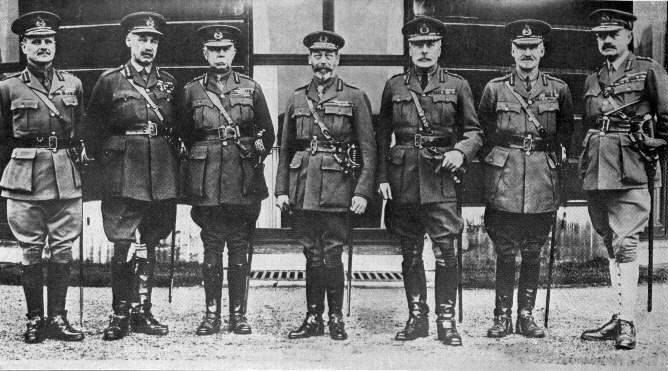
2. From left to right: G.-S. Rawlinson, G. Ch. Plumer, D. G. Bing, King George V, D. Haig, G. S. Horn.
On the evening of 26, a break between the British and the French was closed.
This moment became a crisis of operation. If before him the German offensive went on increasing, then from March 27 it continued though (even with success), but nevertheless it began to fade out gradually. Allied resistance is becoming increasingly steadfast.
F. Foch tried to concentrate maximum forces north of the Oise, causing reserves from Alsace-Lorraine and Italy. Until April 5, he managed to pull into the area: 14 corps commanders, 2 commanders of cavalry corps, 45 infantry and 6 cavalry divisions.
The appearance of large French forces north of the Oise and, accordingly, March 25, a noticeable increase in resistance on the left flank of the 18 Army, raised the question of a scheme for further actions against the French before the German command.
The initial plan of the operation, as we noted, was broken by 23 in March, when part of the 2 and 18 armies were ordered to advance westward through the Somme - which they managed to leave behind March 26. Even then, the center of gravity of the operation was shifted to the southern flank. Now, still starting from the fact of a major tactical success on the front of the 18 Army, the High Command found it necessary to continue the offensive in this direction - and beat the appropriate French reserves in parts. The new goal expanded the original task - now both the British and the French had to be crushed at the same time. Moreover, the largest part of the German forces - part of the 2 and 18 armies - were to strike at the French. The British were considered so defeated that the 17-I army and one was recognized strong enough to finally do away with them.
Thus, the strategic objectives of the operation were changed. Accordingly, the direction of attack has changed.
March 26. The High Command issued a directive according to which the 18 Army should make a right shoulder traverse along the Avra River, advancing on the Right flank at Tartigny and the left flank at Compiegne, and the Left Flank should advance south of the Somme (through Avru) and further to Breteuil. The 2 Army was to continue the offensive in the western and north-western directions - the right flank in the S. Paul and the left in Airen. At the same time, the 17 and 4 armies were instructed to complete the preparation of the Mars attack.
Thus, the greatest forces were now heading south-west — and the operation received the opposite direction to the original one. The following scheme for moving reserves during an operation illustrates this fact.
2 schema. The movement of German reserves.
Moreover, the new lines of attack were becoming eccentric, and the strike force from the 3's armies turned into wide-spread fingers. This also had serious tactical consequences: the front of the offensive increased significantly, and its length no longer corresponded to the forces brought into battle. The battle lines became more rarefied, and the force of the strike weakened noticeably. In addition, the offensive could not be supported by so powerful as before artillery - the nomination of the latter through the dug up shells and wire fields of battle became very difficult and often impossible. In this situation, a tank could be useful, so unfairly underestimated by the German High Command.
As a result, while the Allied forces grew and fought with increasing stamina, the Germanic forces resolved in space - and weakened. These circumstances predetermined the further course of the offensive, which, despite the success achieved in the future, began to decline since March 26.
March 27 The 17 Army unsuccessfully attacked Arras, advancing only in the area of Buqua.
The 2 Army was met with powerful English counterattacks from Albert and was able to advance only along the Somme, where it took Say. It became obvious that the German offensive north of the Somme was getting exhausted.
3. Germans are infantrymen in the Somme region. 1918 year.
To be continued
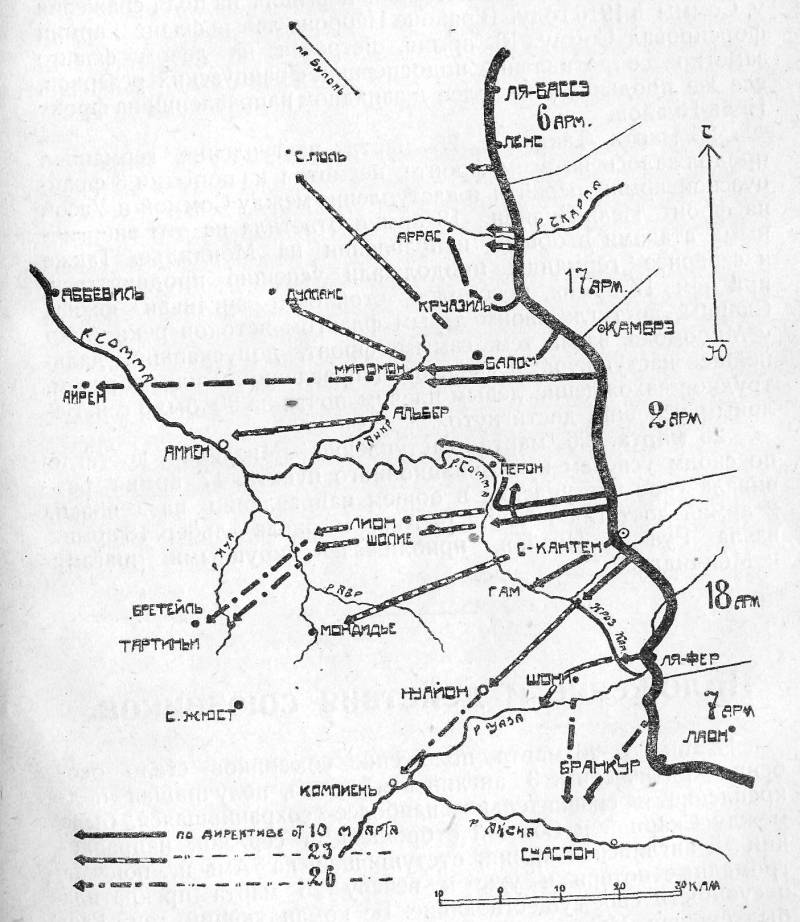
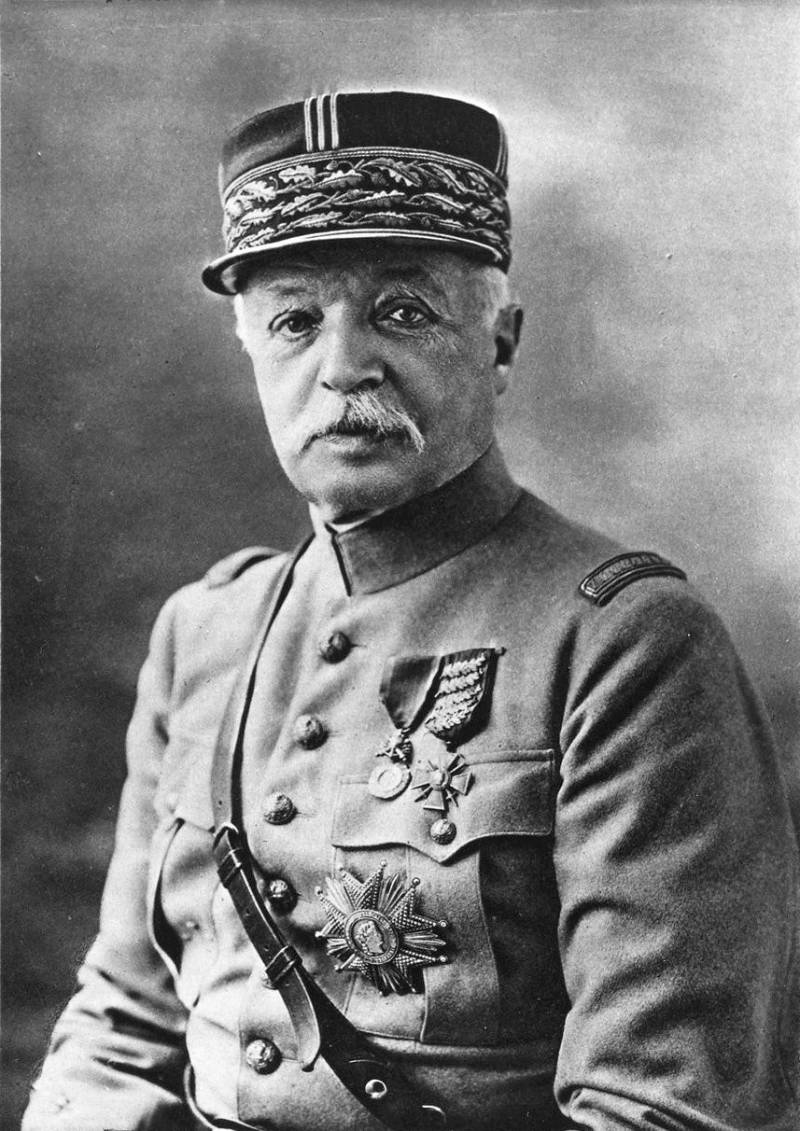
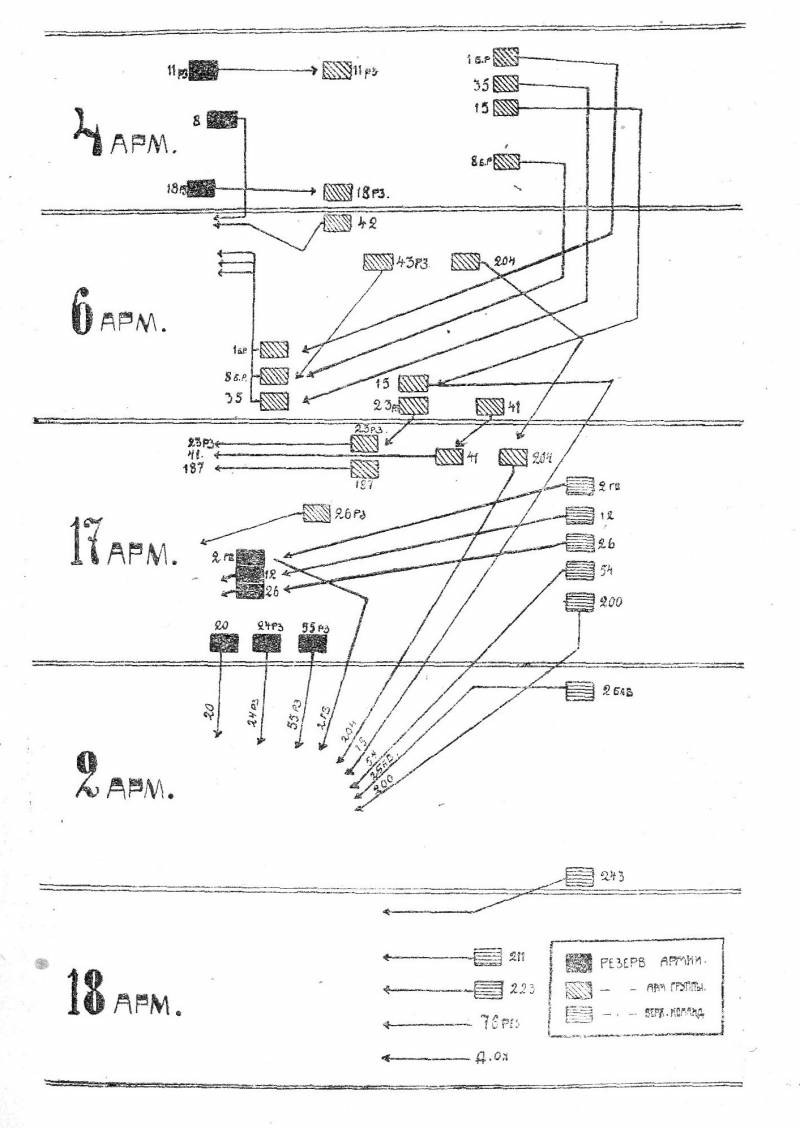
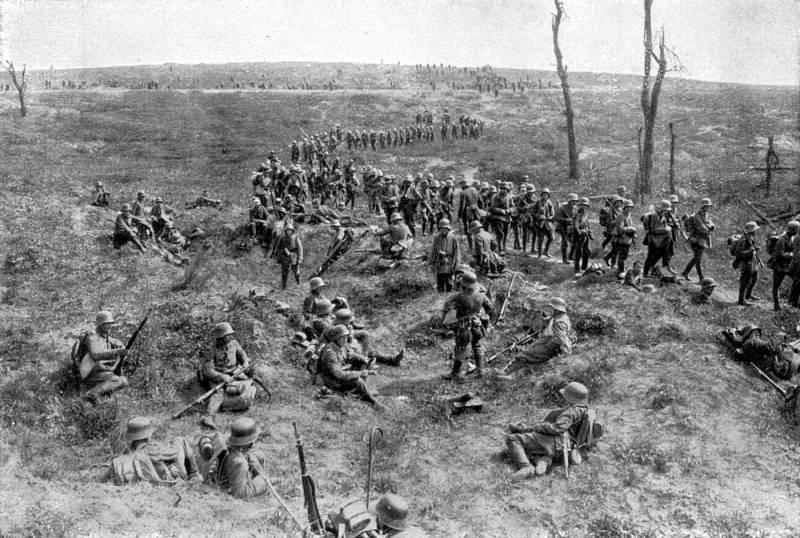
Information